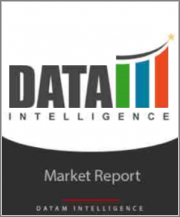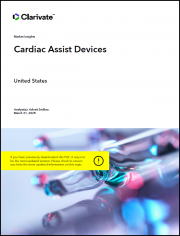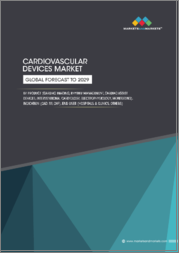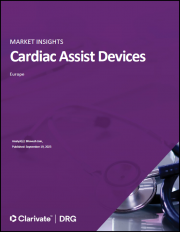
|
시장보고서
상품코드
1373386
세계 심장 보조 기기 시장(2023년-2030년)Global Cardiac Assist Devices Market - 2023-2030 |
||||||
개요
심장 보조 순환 장치(CAD)는 심각한 심장 질환 환자의 순환 기능을 지원하는 혈액 펌프입니다. 이것은 심장이 더 많은 혈액을 보내는 것을 돕도록 설계된 기계식 펌프 장치입니다. 심장으로부터 송출된 혈액을 전신에 송출하는 것으로 심장의 부담을 경감합니다.
심박 조율기는 흉부에 장착되는 소형 의료기기로 전기 펄스를 사용하여 심장이 정상 범위에서 박동하도록 촉구함으로써 비정상적인 심장 리듬을 제어하는 데 도움이 됩니다. 심장 보조 기기는 현재 심장 이식에 교량으로 심각한 심부전의 치료에 일반적으로 사용되고 있습니다.
시장 역학 : 촉진요인 및 억제요인
심부전 환자 수 증가
심부전 환자 증가는 심장 보조 기기의 사용과 응용을 증가시킵니다. 보조 인공 심장은 신체의 다른 부위에서 심장으로 혈액을 보내는 데 도움이 됩니다.
예를 들어, 2022년에 발표된 보고서에 따르면 심부전의 유병률은 세계에서 2,600만 명으로 추정되어 세계 건강 비용 증가에 기여합니다. 심부전은 높은 이환율과 사망률을 수반되는 질병으로서 세계적으로 여전히 높은 빈도로 만연하고 있습니다.
게다가 AHA 저널이 발표한 보고서에 따르면 심부전의 유병률은 600만 명으로 추정되며, 이는 미국 총 인구의 약 1.8%에 해당합니다. 또한 조사에 따르면 2030년까지 심부전 유병률은 46% 증가했으며 미국에서는 800만 명 이상에 달할 것으로 예측되고 있습니다. 따라서 심부전 환자 수 증가는 시장 성장을 증가시킬 것으로 예상됩니다.
억제요인
장비 및 처치의 비용 높음
장비 및 처치에 드는 비용 증가는 시장 성장을 방해할 수 있습니다. 첫 입원을 포함한 123일간의 치료 비용은 LVAD가 197,957 USD, 심장 이식이 151,646 USD입니다.
목차
제1장 조사 방법과 조사 범위
제2장 정의 및 개요
제3장 주요 요약
제4장 시장 역학
- 영향요인
- 성장 촉진요인
- 심부전 환자수 증가
- 억제요인
- 기기나 처치에 수반되는 고비용
- 기회
- 영향 분석
- 성장 촉진요인
제5장 산업 분석
- Porter's Five Forces 분석
- 공급망 분석
- 가격 분석
- 규제 분석
- 러시아 및 우크라이나 전쟁의 영향 분석
- DMI 의견
제6장 COVID-19 분석
제7장 제품별
- 심실 보조 장치
- 전체 인공 심장
- 대동맥 풍선 펌프
- 기타
제8장 용도별
- 심장이식 가교치료(BTT)
- 목적 치료
- 기타
제9장 최종 사용자별
- 병원
- 클리닉
- 외래수술센터(ASC)
- 기타
제10장 지역별
- 북미
- 미국
- 캐나다
- 멕시코
- 유럽
- 독일
- 영국
- 프랑스
- 이탈리아
- 스페인
- 기타 유럽
- 남미
- 브라질
- 아르헨티나
- 기타 남미
- 아시아태평양
- 중국
- 인도
- 일본
- 호주
- 기타 아시아태평양
- 중동 및 아프리카
제11장 경쟁 구도
- 경쟁 시나리오
- 시장 포지셔닝 및 점유율 분석
- M&A 분석
제12장 기업 프로파일
- Medtronic Plc
- 기업 개요
- 제품 포트폴리오와 설명
- 재무 개요
- 주요 발전
- Abiomed Inc.
- SynCardia Systems
- Calon Cardio-Technology Ltd.
- Teleflex Incorporated
- Abbott Laboratories
- BiVACOR Inc.
- Berlin Heart GmbH
- EVAHEART, INC.
- Jarvik Heart, Inc.
제13장 부록
BJH 23.11.17Overview
Cardiac assist devices (CAD) are blood pumps that support the circulatory functions of severely ill cardiac patients. These are mechanical pumping devices designed to help the heart pump more blood. They work by taking blood from the heart and pumping it to the rest of the body, thus taking the burden off the heart.
These are small medical devices placed in the chest, a pacemaker helps control abnormal heart rhythms by using electrical pulses to prompt the heart to beat at a normal range. Cardiac assist devices are now commonly used in the treatment of severe heart failure as bridges to cardiac transplants.
Market Dynamics: Drivers & Restraints
Increase in the number of heart failure cases
An increase in the number of heart failure cases will increase the usage and application of cardiac assist devices. They help in pumping blood to the heart from other parts of the body.
For instance, according to the report published in 2022, it is estimated that heart failure has an estimated prevalence of 26 million people worldwide and contributes to increased healthcare costs worldwide. Heart failure remains a highly prevalent disorder worldwide with a high morbidity and mortality rate.
Additionally, according to the report published by AHA Journal, it is estimated that the prevalence of heart failure is 6 million, approximately 1.8% of the total US population. It also said that researchers have predicted a 46% increase in heart failure prevalence by 2030, reaching more than 8 million people in the US. Thus, the increase in the number of heart failures is expected to raise the market growth.
Restraint
High costs of devices and the procedures
Increasing costs for the devices and procedures can hamper the market growth, as only few individuals can afford the treatment procedure cost. The overall cost for the 123 days of care including initial hospitalization was $197 957 for LVADs and $151 646 for heart transplants.
Segment Analysis
The global cardiac assist devices market is segmented based on product, application, end-user, and region.
Ventricular assist device segment accounted for 48.3% of the market share
Ventricular assist devices segment is expected to hold a dominant share in the global cardiac assist devices market. A ventricular assist device (VAD) is a device that helps pump blood from the lower chambers of the heart to the rest of the body. The advantages of the devices over other types are holding the segment in the dominant position.
Left Ventricular Assist Devices (LVADs) are mechanical devices that are implanted in patients with advanced heart failure, help the heart pump blood more effectively, and could benefit patients with advanced heart failure as they await donors. They improve the function of the kidneys, liver, brain, and other organs by increasing blood flow to the body.
Additionally, the increase in the number of heart diseases, and increase in the geriatric population, and the increase in the number of launches of the devices are expected to drive the segment's growth. Thus, the above factors are expected to hold a significant position in the market share.
Geographical Analysis
North America is expected to hold a significant position in the global cardiac assist devices market share
North America holds a dominant share in the cardiac assist devices market share owing to the technological advancements in the field of cardiac assist devices and the rise in the prevalence of heart diseases which is expected to continue throughout the forecast period.
For instance, on July 11, 2023, SynCardia Systems, LLC., received the U.S. Food and Drug Administration (FDA) approval for the update of the SynCardia TAH-t label with real-world data further confirming the safety and performance of the Companion 2 Driver.
Additionally, on August 29, 2022, has released new late-breaking data that show its HeartMate 3 heart pump extends the survival of advanced heart failure patients by at least five years, providing a clear life-saving option for people battling later-stage disease for which it has received the US approval in 2020. Thus, the above factors are expected to drive the market growth in this region.
COVID-19 Impact Analysis:
The COVID-19 has impacted the cardiac assist devices market negatively. The reduction in the number of cardiovascular surgeries and the closure of hospitals during the period of lockdown has impacted the market growth. People refused to visit hospitals for treatment procedures because of the spread of the virus.
Competitive Landscape
The leading companies with a significant market share include: Medtronic Plc, Abiomed Inc., SynCardia Systems, Calon Cardio-Technology Ltd., Teleflex Incorporated, Abbott Laboratories, BiVACOR Inc., Berlin Heart GmbH, EVAHEART, INC., and Jarvik Heart, Inc.
Key Developments
- On January 24, 2023, Terumo, Japan's largest maker of medical supplies, established a wholly-owned subsidiary in the US. It has launched the US LVAD (left ventricular heart assist device) business.
- On June 26, 2021, CARMAT introduced the first implant of its Aeson bioprosthetic artificial heart in Germany.
Why Purchase the Report?
- To visualize the global cardiac assist devices market segmentation based on product, application, end-user, and region, as well as understand key commercial assets and players.
- Identify commercial opportunities by analyzing trends and co-development.
- Excel data sheet with numerous data points of cardiac assist devices market-level with all segments.
- PDF report consists of a comprehensive analysis after exhaustive qualitative interviews and an in-depth study.
- Product mapping available as excel consisting of key products of all the major players.
The global cardiac assist devices market report would provide approximately 59 tables, 61 figures, and 187 Pages.
Target Audience 2023
- Manufacturers/ Buyers
- Industry Investors/Investment Bankers
- Research Professionals
- Emerging Companies
Table of Contents
1. Methodology and Scope
- 1.1. Research Methodology
- 1.2. Research Objective and Scope of the Report
2. Definition and Overview
3. Executive Summary
- 3.1. Snippet by Product
- 3.2. Snippet by Application
- 3.3. Snippet by End-User
- 3.4. Snippet by Region
4. Dynamics
- 4.1. Impacting Factors
- 4.1.1. Drivers
- 4.1.1.1. Increase in the number of heart failure cases
- 4.1.1.2.
- 4.1.2. Restraints
- 4.1.2.1. High costs associated with the devices and procedures
- 4.1.3. Opportunity
- 4.1.4. Impact Analysis
- 4.1.1. Drivers
5. Industry Analysis
- 5.1. Porter's Five Force Analysis
- 5.2. Supply Chain Analysis
- 5.3. Pricing Analysis
- 5.4. Regulatory Analysis
- 5.5. Russia-Ukraine War Impact Analysis
- 5.6. DMI Opinion
6. COVID-19 Analysis
- 6.1. Analysis of COVID-19
- 6.1.1. Scenario Before COVID
- 6.1.2. Scenario During COVID
- 6.1.3. Scenario Post COVID
- 6.2. Pricing Dynamics Amid COVID-19
- 6.3. Demand-Supply Spectrum
- 6.4. Government Initiatives Related to the Market During Pandemic
- 6.5. Manufacturers Strategic Initiatives
- 6.6. Conclusion
7. By Product
- 7.1. Introduction
- 7.1.1. Market Size Analysis and Y-o-Y Growth Analysis (%), By Product
- 7.1.2. Market Attractiveness Index, By Product
- 7.2. Ventricular Assist Device *
- 7.2.1. Introduction
- 7.2.2. Market Size Analysis and Y-o-Y Growth Analysis (%)
- 7.3. Total Artificial Heart
- 7.4. Intra-Aortic Balloon Pump
- 7.5. Others
8. By Application
- 8.1. Introduction
- 8.1.1. Market Size Analysis and Y-o-Y Growth Analysis (%), By Application
- 8.1.2. Market Attractiveness Index, By Application
- 8.2. Bridge-to-transplant (BTT) Therapy *
- 8.2.1. Introduction
- 8.2.2. Market Size Analysis and Y-o-Y Growth Analysis (%)
- 8.3. Destination Therapy
- 8.4. Others
9. By End-User
- 9.1. Introduction
- 9.1.1. Market Size Analysis and Y-o-Y Growth Analysis (%), By End-User
- 9.1.2. Market Attractiveness Index, By End-User
- 9.2. Hospitals *
- 9.2.1. Introduction
- 9.2.2. Market Size Analysis and Y-o-Y Growth Analysis (%)
- 9.3. Clinics
- 9.4. Ambulatory Surgical Centers
- 9.5. Others
10. By Region
- 10.1. Introduction
- 10.1.1. Market Size Analysis and Y-o-Y Growth Analysis (%), By Region
- 10.1.2. Market Attractiveness Index, By Region
- 10.2. North America
- 10.2.1. Introduction
- 10.2.2. Key Region-Specific Dynamics
- 10.2.3. Market Size Analysis and Y-o-Y Growth Analysis (%), By Product
- 10.2.4. Market Size Analysis and Y-o-Y Growth Analysis (%), By Application
- 10.2.5. Market Size Analysis and Y-o-Y Growth Analysis (%), By End-User
- 10.2.6. Market Size Analysis and Y-o-Y Growth Analysis (%), By Country
- 10.2.6.1. U.S.
- 10.2.6.2. Canada
- 10.2.6.3. Mexico
- 10.3. Europe
- 10.3.1. Introduction
- 10.3.2. Key Region-Specific Dynamics
- 10.3.3. Market Size Analysis and Y-o-Y Growth Analysis (%), By Product
- 10.3.4. Market Size Analysis and Y-o-Y Growth Analysis (%), By Application
- 10.3.5. Market Size Analysis and Y-o-Y Growth Analysis (%), By End-User
- 10.3.6. Market Size Analysis and Y-o-Y Growth Analysis (%), By Country
- 10.3.6.1. Germany
- 10.3.6.2. UK
- 10.3.6.3. France
- 10.3.6.4. Italy
- 10.3.6.5. Spain
- 10.3.6.6. Rest of Europe
- 10.4. South America
- 10.4.1. Introduction
- 10.4.2. Key Region-Specific Dynamics
- 10.4.3. Market Size Analysis and Y-o-Y Growth Analysis (%), By Product
- 10.4.4. Market Size Analysis and Y-o-Y Growth Analysis (%), By Application
- 10.4.5. Market Size Analysis and Y-o-Y Growth Analysis (%), By End-User
- 10.4.6. Market Size Analysis and Y-o-Y Growth Analysis (%), By Country
- 10.4.6.1. Brazil
- 10.4.6.2. Argentina
- 10.4.6.3. Rest of South America
- 10.5. Asia-Pacific
- 10.5.1. Introduction
- 10.5.2. Key Region-Specific Dynamics
- 10.5.3. Market Size Analysis and Y-o-Y Growth Analysis (%), By Product
- 10.5.4. Market Size Analysis and Y-o-Y Growth Analysis (%), By Application
- 10.5.5. Market Size Analysis and Y-o-Y Growth Analysis (%), By End-User
- 10.5.6. Market Size Analysis and Y-o-Y Growth Analysis (%), By Country
- 10.5.6.1. China
- 10.5.6.2. India
- 10.5.6.3. Japan
- 10.5.6.4. Australia
- 10.5.6.5. Rest of Asia-Pacific
- 10.6. Middle East and Africa
- 10.6.1. Introduction
- 10.6.2. Key Region-Specific Dynamics
- 10.6.3. Market Size Analysis and Y-o-Y Growth Analysis (%), By Product
- 10.6.4. Market Size Analysis and Y-o-Y Growth Analysis (%), By Application
- 10.6.5. Market Size Analysis and Y-o-Y Growth Analysis (%), By End-User
11. Competitive Landscape
- 11.1. Competitive Scenario
- 11.2. Market Positioning/Share Analysis
- 11.3. Mergers and Acquisitions Analysis
12. Company Profiles
- 12.1. Medtronic Plc *
- 12.1.1. Company Overview
- 12.1.2. Product Portfolio and Description
- 12.1.3. Financial Overview
- 12.1.4. Key Developments
- 12.2. Abiomed Inc.
- 12.3. SynCardia Systems
- 12.4. Calon Cardio-Technology Ltd.
- 12.5. Teleflex Incorporated
- 12.6. Abbott Laboratories
- 12.7. BiVACOR Inc.
- 12.8. Berlin Heart GmbH
- 12.9. EVAHEART, INC.
- 12.10. Jarvik Heart, Inc.
LIST NOT EXHAUSTIVE.
13. Appendix
- 13.1. About Us and Services
- 13.2. Contact Us















